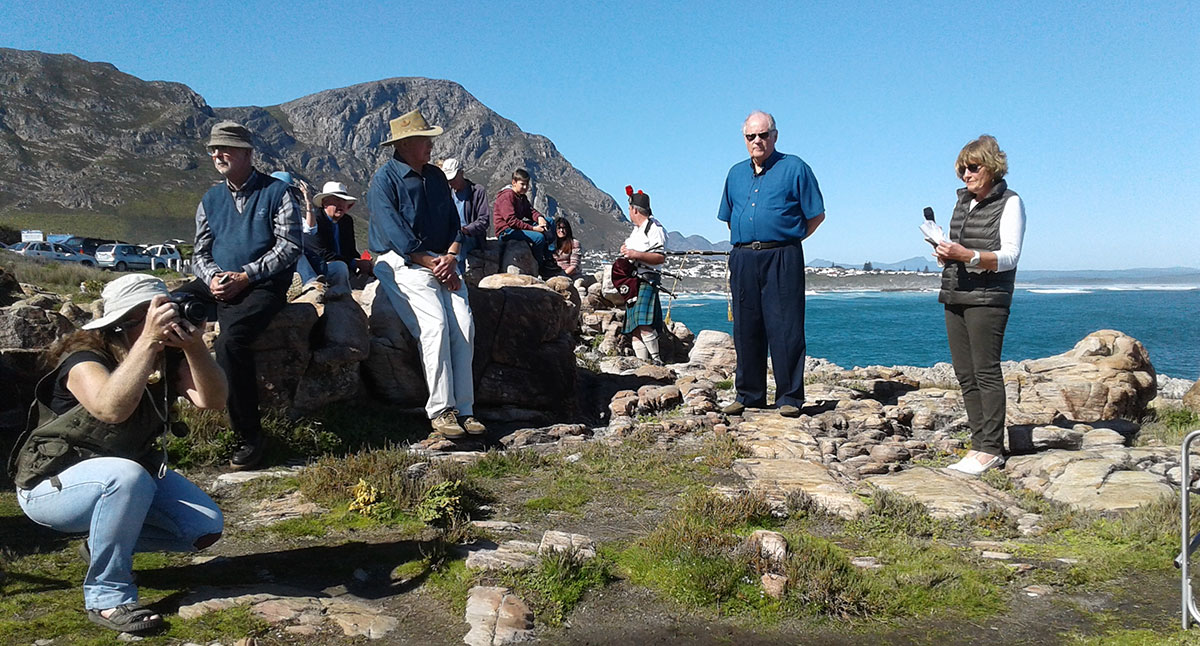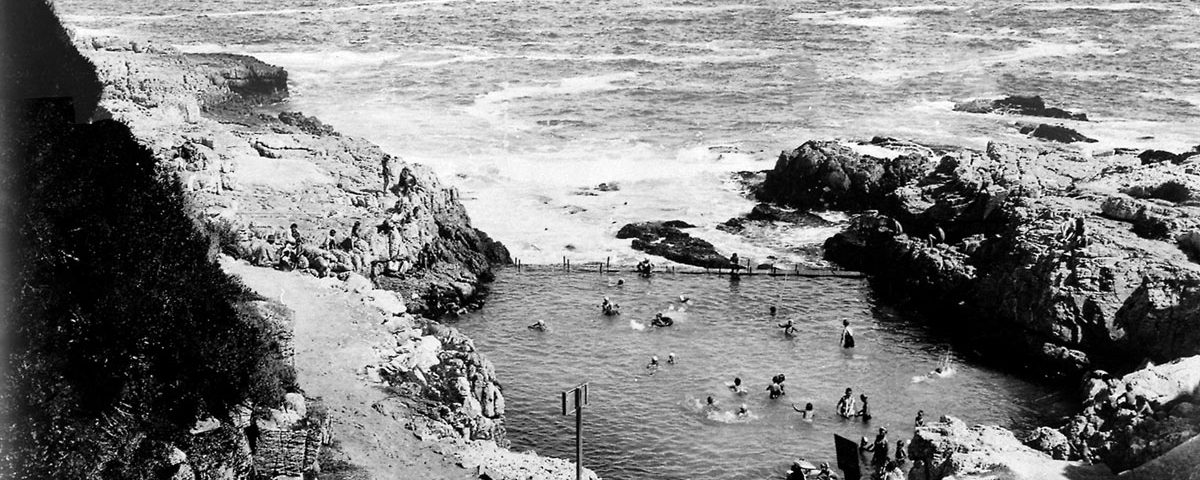
Victoria Cross Remembered – 100 years later
October 5, 2017
Heart and Home report
February 5, 2018In 2017 Fick’s Pool is one of the lesser-known amenities in Hermanus. Probably not one in twenty shoppers at the supermarkets will know what it is or where it is. But it has been in existence in one form or another for 90 years and has provided exercise, bathing opportunities and teenage romance for thousands. It will quite soon become the location of a modern restaurant.
Fick’s Pool is situated below Marine Drive where the formal houses on the ocean side of Westcliff Road, where there is a tarred parking area. Next to the parking area, the ground drops away quite sharply towards the ocean. There is a narrow inlet from the open sea to a sheltered cove.
In the 1920s a concrete wall was built across the opening, creating a tidal swimming pool. Waves break with considerable force into the pool if the sea is at all rough and scour out sand and water that has stood for too long. As a result swimming in the pool is a very refreshing experience. At present it is seriously under-utilised.
The general area is one of the oldest in Hermanus. The first surveyed sites for home building were above Fick’s Pool. In 1854, while Hermanuspietersfontein was still the unofficial name of the village, nine sites were put up for sale by the Municipality at £1. 4s each (R2.40). Jose Burman writes:
Whether they (the sites) were worth more than that is doubtful. The soil was rocky and infertile, totally unsuited to farming…the plots lay opposite the spring, along the northwest side of the present Marine Drive, from Fick’s Pool to the present Main Road.
Nevertheless the area became popular and plots changed hands over time and more plots on the western side were made available.
There are two different explanations of how Fick’s Pool got its name. The account you will see in most books and on most websites dates the construction of the wall to the late 1920s or early 1930s. At that time the only government school in Hermanus was the ‘Klipskool’, which catered for primary and some secondary education. The Principal during the 1920s and early 1930s was a Mr. J J Fick, whose family lived in a house on one of the sites above the swimming ‘gat’ as it was then called. Times were tough economically and there was little money available to provide entertainment to young people during weekends and holidays.
Children from families living in Mossel River and Voelklip had access to several beaches (Langbaai, Voelklip, Kammabaai and Grotto) and could entertain themselves. But there was nothing to do in the town itself, except hanging around the ‘Visbaai’, watching the fisherman and getting into bad habits. We know that the Oblowitz family which owned a prosperous general dealers store at the corner of Main and Harbour Roads actually sold up and returned to Cape Town because their only son, Sidney could not be prevented from hanging out with suspect companions at the Visbaai.
Mr. Fick petitioned the Council to create a swimming pool in front of his house. This involved considerable blasting of the rocky cliffs and the removal of a large pointed rock formation that would have been in the middle of the pool. Then the concrete wall was built and, a little later, basic wooden changing facilities were added. These were painted white and were erected on the inland side of the pool. It seemed a good thing to name the pool after the man who had motivated its construction and so Fick’s Pool came into existence, probably in 1933. It was an immediate hit.
The second explanation is more prosaic, but contains more verifiable data. Another branch of the Fick family had been living in the Caledon area since at least the 1870s. We know this because Josias Servaas Fick, of the farm Weltevreden served as Field Cornet for the Caledon ward from 1870 to 1885. There is a documentary record that on 16 August 1889 the erf (plot) adjacent to the nine previously sold was granted on a quitrent basis to the same Josias Fick. The erf extended from the high water mark at the pool right through to Church Street. The plots were deliberately large, enabling the keeping of chickens, a cow and sheep.
Josias Servaas Fick began to spend time at his holiday home and got into the habit of going for a morning swim each day. He also successfully persuaded others to join him and soon people were referring to “Fick se Gat” which was later changed and anglicised into Fick’s Pool.
Either way, by 1930 young people were enjoying days at the Pool. They had started to use a term of endearment for the pool: “Fikkie’s Pool”. Numerous photographs show youngsters using the facilities, but the best written description I can find refers to Fick’s Pool in the 1940s:
When we were approaching our teenage years, Fikkie’s Pool was our summer haunt. The beaches of Voelklip and the New Beach as we called the Grotto Beach then, were out of our reach as none of us had any means of transport. Many years later I returned to Hermanus and saw that the name had been changed from Fikkie’s Pool to Mermaid’s Pool, a concept which is not tailored to my memory at all. Fikkie’s Pool was not a pretty bedtime fantasy — it was where it all happened – splashing in the tidal pool, being frightened when the high tide swept over the retaining wall, clambering over the large rocks and spreading a towel on the warm stone, to lie for hours with the glow of sun on your back. It was giggling and gossiping and taking shy peeks at the opposite sex. It was showing off and innocent flirting with the exciting uncertainties of romance. It was where the boys challenged each other to what seemed to us then, death-defying dives from the top of the cliff just outside the sea wall of the pool. Even I rose to the challenge of swimming across the stretch between the cliffs on the sea-side of the wall, after we had been told that a shark had been spotted there. I probably did not believe the story because I was always a total coward and I cannot imagine anything persuading me to swim anywhere remotely near a shark. Well, maybe one thing — perhaps there was a boy I wanted to impress. Fikkie’s Pool was an idyll. Mermaids’ Pool seems too bland a name for such a place of youthful passion.
Fick’s Pool was developed piecemeal over its life. A major renovation was done in 1965. Municipal workers removed a large amount of loose rock from the bed of the pool. The Rotary Club funded work to extend the seaward side to give the Pool a length of 50 metres and raising its height. A diving board was mooted, but I have no record that it was installed.
Another story linked to Fick’s Pool is tragic and concerns the death of a member of an original settler family, the Warringtons. Arderne Tredgold describes the event in this way:
Robin Lee
Hermanus Times 14 December 2017
The backdrop for young love and adventure

